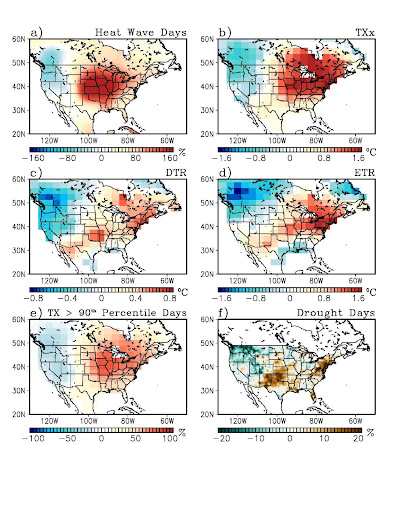Heat extremes are the number one weather-related cause of death in the United States, prompting the climate community to study the driving forces behind these extreme events to improve their prediction. A new study published in the Journal of Geophysical Research finds an increase in summertime heat wave occurrence over the US Great Plains is linked to a larger than normal tropical Atlantic warm pool.
The Atlantic warm pool is a large body of warm water in the low latitudes of the North Atlantic, which includes the Gulf of America, Caribbean Sea, and western tropical North Atlantic. Using observational data and model simulations, this study finds that the year-to-year variability of the tropical Atlantic warm pool influences heat wave occurrence over the US Great Plains during the Northern Hemisphere’s summer months (June – September).
This study, led by NOAA’s Atlantic Oceanographic & Meteorological Laboratory (AOML), the University of Miami’s Cooperative Institute for Marine and Atmospheric Studies, and Mississippi State University’s Northern Gulf Institute, finds that a larger than normal Atlantic warm pool influences atmospheric circulation patterns over the Caribbean Sea and Gulf of America, promoting a “heat dome” pattern over the Great Plains. This pattern reduces cloud cover and enhances surface warming and heat wave occurrence.

The Great Plains is a region where soil moisture and surface air temperatures are strongly correlated. In spring and summer, one-third of the total moisture transport in the Great Plains is caused by the Great Plains low-level jet (GPLLJ). A weaker GPLLJ leads to less precipitation, which increases the likelihood of extreme temperature and heat wave days.
Additionally, the variability of the GPLLJ from one year to the next has been linked to sea surface temperature variability in the tropical Atlantic. This work finds that a large Atlantic warm pool weakens the GPLLJ, which causes less precipitation in the Great Plains, eventually leading to drought conditions and increased heat wave occurrence for most of the US east of the Rocky Mountains.
“Extreme heat events are responsible for large mortality and vast economic impact in the U.S. Hence, enhancing our understanding of the mechanisms causing their occurrence should lead to providing emergency managers, government officials, businesses, and the public in general better advance warning to minimize catastrophic loss of life and damage to critical infrastructure,” said Hosmay Lopez, AOML scientist and lead author of the study. “This effort is crucial for informing public health security and impact mitigation strategies, filling the gap and developing effective extreme heat prediction to help communities be better prepared.”
Understanding the physical mechanisms modulating heat wave occurrence is essential for improving the predictability and future projections of extreme heat events. While sea surface temperature anomalies in the tropical Atlantic can be skillfully forecast 3-4 months in advance, heat waves are only able to be predicted on a 7-10 day timescale. Given the longer predictability of these anomalies, understanding the connection between the two could lead to earlier predictions of US heat waves.
